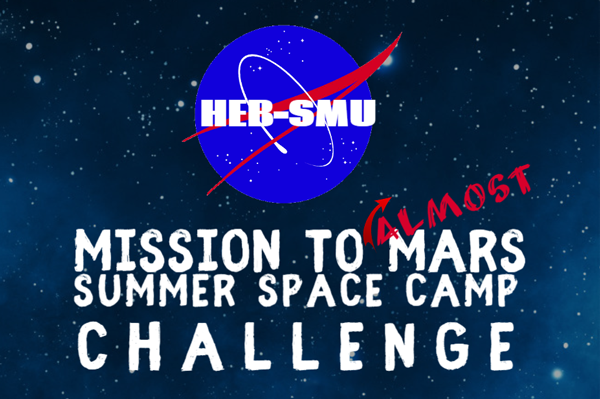Hurst-Euless-Bedford (HEB) Independent School District (ISD) and Southern Methodist University’s (SMU) Mars 2021 Mission on June 18, 2021
The culmination landing will begin at noon on June 18 at L. D. Bell High School Auditorium

The Texas Workforce Commission awarded the Caruth Institute for Engineering Education (CIEE) in the SMU Lyle School of Engineering, a Governor’s Summer Merit grant to hold the Mars 2021 Program with HEB ISD. Dr. Kenneth Berry from the CIEE wrote the proposal and is the Principal Investigator of the grant.
HEB ISD and SMU are partnering to host the Mars 2021 Mission this summer. The one-week camp is funded by a generous grant from the Texas Workforce Commission (TWC), the Governor’s Summer Merit Program. The camp is a simulation of NASA’s Mars 2020 Mission that landed successfully on Mars on February 18, 2021. Our mission includes rockets, a Martian landscape, drones and rovers. The culmination landing will begin at noon on June 18 at L. D. Bell High School Auditorium, 1601 Brown Trail, Hurst, TX 76054.
One hundred and twenty high school foster students, minority students, and girls were recruited for the camp. The students each chose one of four teams to attend: rocketry, rovers, drones or landing terrain. They worked on their teams during the week to design their rockets, rovers or drones to land on “Mars” on Friday.
During the week, the rocketry team designed and launched rockets to simulate boosting the rover and drone into orbit, and on to Mars.
During the week, the Mars Terrain team created a Mars landing site for the rovers and drones. On the first day they identified an appropriate landing site using NASA scientific data and engineering requirements. During the rest of the week they created a simulated Martian surface for the rover and drone teams to explore. No other team has been allowed to observe the Martian landscape. The terrain team, however, did provide the rover and drone teams with materials from Mars so that they would be able to practice moving over the Martian landscape.
The drone team will be responsible for reconnaissance on Mars. The team designed their drones to accomplish their mission. During the week, they learned to fly, modify, gather navigation information, and program their drones. Their drones are inspired by NASA’s Ingenuity Drone that landed successfully with the Perseverance Rover on Mars. During the Landing on Mars they will fly over the Martian landscape and use their onboard cameras to remotely identify the interesting rock samples for the rovers, and chart safe passage for the rovers to retrieve the samples. The drone cameras will be the team’s only “eyes” on Mars.
The rover team created a rover to operate on “Mars,” like the Perseverance Rover that NASA landed successfully on Mars in February. Their mission is to locate, analyze and retrieve rock samples from the surface of Mars. During the week the students on the rover team learned to build rovers, drive rovers, program rovers, test rovers on potential Mars materials, and remotely send programs to the rovers. During the Landing on Friday they will only be able to see the Mars landing area through the rover cameras. Using the cameras and the flight data from the drones they will attempt to retrieve valuable rock samples from the landing site.
The Mars Landing will start at noon on Friday June 18 with the launch sequence and launch. The Mars teams will then present what their teams accomplished over the week and what they hope to accomplish on the Mars Landscape after landing. Then the drones will land on Mars and begin their reconnaissance of the landing area. After they view the landscape they will pass off their maps of the terrain to the rover team who will begin programming their rover to navigate to, and retrieve valuable rock samples. After the mission is completed the students will be able to view the Mars Landscape by going to visit it. The landing will be completed by 2:30 PM.
SMU Contact: Dr. Kenneth Berry, ksberry@smu.edu
HEB ISD Contact: Kiera Elledge, kieraelledge@hebisd.edu